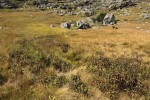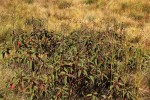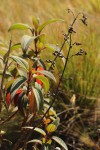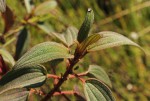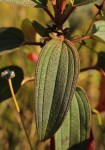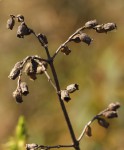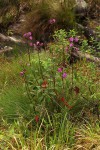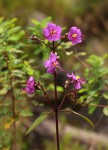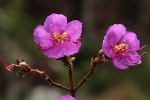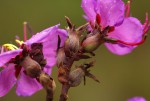Dissotis pulchra
Selected images: Click on each image to see a larger version and details of the record View all images (10)
Detailed records: Display species records QDS maps by: Google Maps Point records by Google Maps
Species details: Click on each item to see an explanation of that item (Note: opens a new window)
| Synonyms: | |
| Common names: | |
| Frequency: | |
| Status: | Native |
| Description: |
A tall perennial herb or shrub up to 3·5 m high. Leaves 3-whorled, ovate-lanceolate or ovate, 3–15·5 x 1·6–7 cm long, cordate or subcordate at base, very discolorous, light to dull green above, pale- to yellowish-green beneath, covered with short bristly pustules above and short yellowish hairs beneath; margin finely toothed, teeth prolonged from the base by branched bristles; petiole 0·5–3 cm long. Flowers 5-merous, in terminal, elongated, lax panicles; bracts ovate, 12–13·5 mm long, purple inside, densely white-scaly outside, falling early; pedicels up to 2 mm long. Receptacle oblong-cylindric, 9–11 mm long, densely set with short whitish bristles, usually not divided. Sepals oblong-lanceolate, 8–9 mm long, hairless and purple inside, densely bristly outside, with long bristles at the apex. Petals obovate, c. 3 cm long, mauve to bright purple, ciliate at margin. Fruiting receptacle 10–11 mm long, slightly constricted above the capsule. Capsule subspherical or widely ovoid, c. 8 mm and 6–7 mm wide, appressed-bristly on the upper 1/3. |
| Type location: |
Chimanimani Mts, Zimbabwe |
| Notes: | Although this taxon is considered an endemic in the Chimanimani Mts, it is very similar to the more widespread Dissotis trothae from East and Central Africa. Further research will have to establish whether these two taxa are distinct. |
| Derivation of specific name: | pulchra: beautiful |
| Habitat: | Along streams, sometimes in rock crevices. |
| Altitude range: (metres) | |
| Flowering time: | |
| Worldwide distribution: | Restricted to the Chimanimani Mts of Mozambique and Zimbabwe. |
| FZ divisions: | E |
| Growth form(s): | |
| Endemic status: | Near Endemic |
| Red data list status: | |
| Insects associated with this species: | |
| Spot characters: | Display spot characters for this species |
| Images last updated: | Wednesday 4 June 2014 |
| Literature: |
Burrows, J.E., Burrows, S.M., Lötter, M.C. & Schmidt, E. (2018). Trees and Shrubs Mozambique Publishing Print Matters (Pty), Cape Town. Page 706. (Includes a picture). Chapano, C. & Mamuto, M. (2003). Plants of the Chimanimani District National Herbarium and Botanic Garden, Zimbabwe Page 22. Darbyshire, I., Timberlake, J., Osborne, J., Rokni, S., Matimele, H., Langa. C., Datizua, C., de Sousa, C., Alves, T., Massingue, A., Hadj-Hammou, J., Dhanda, S., Shah, T., Wursten, B. (2019). The endemic plants of Mozambique: diversity and conservation status Phytotaxa 136 Page 90. Drummond, R.B. (1975). A list of trees, shrubs and woody climbers indigenous or naturalised in Rhodesia. Kirkia 10(1) Page 264. Fernandes, R. & A. (1978). Melastomataceae Flora Zambesiaca 4 Page 262. Golding, J.S. (ed.) (2002). Zimbabwe Plant Red Data List. Southern African Plant Red Data Lists. SABONET 14 Page 175. Mapaura, A. & Timberlake, J. (eds) (2004). A checklist of Zimbabwean vascular plants Southern African Botanical Diversity Network Report No. 33 Sabonet, Pretoria and Harare Page 61. Plowes, D.C.H. & Drummond, R.B. (1990). Wild Flowers of Zimbabwe. Revised edition. Longman, Zimbabwe. No. 86, plate 117 Timberlake, J.R. & Childes, S.L. (2004). Biodiversity of the Four Corners Area: Technical Reviews Volume Two (Chapter 5-15) Appendix 5-1: Plant Checklist Occasional Publications in Biodiversity 15 Page 219. Wild, H. (1964). The endemic species of the Chimanimani Mountains and their significance Kirkia 4 Page 144. Wursten, B., Timberlake, J. & Darbyshire, I. (2017). The Chimanimani Mountains: an updated checklist. Kirkia 19(1) Page 95. |
Other sources of information about Dissotis pulchra:
Our websites:
Flora of Mozambique: Dissotis pulchraExternal websites:
African Plants: A Photo Guide (Senckenberg): Dissotis pulchraAfrican Plant Database: Dissotis pulchra
BHL (Biodiversity Heritage Library): Dissotis pulchra
EOL (Encyclopedia of Life): Dissotis pulchra
GBIF (Global Biodiversity Information Facility): Dissotis pulchra
Google: Web - Images - Scholar
iNaturalist: Dissotis pulchra
IPNI (International Plant Names Index): Dissotis pulchra
JSTOR Plant Science: Dissotis pulchra
Mansfeld World Database of Agricultural and Horticultural Crops: Dissotis pulchra
Plants of the World Online: Dissotis pulchra
Tropicos: Dissotis pulchra
Wikipedia: Dissotis pulchra
